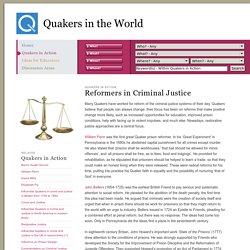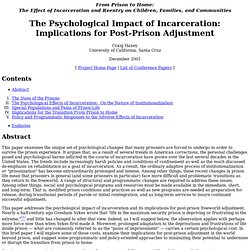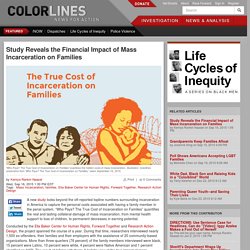

Specialized Courts. The scope of criminal court research and evaluation has grown with the advent of specialized or problem-solving courts.

Examples of specialized courts include drug courts, mental health courts, domestic violence courts and reentry courts. Specialized courts differ from traditional courts in that they focus on one type of offense or offender. Usually the judge plays an intensive supervisory role. Other criminal justice components (e.g., probation) and social services agencies (e.g., drug treatment) are involved and collaborate closely in case processing.
Most specialized court programs are motivated by two sets of goals: Case management to expedite case processing and reduce caseload and time to disposition, thus increasing trial capacity for more serious crimes. BOP: Inmate Custody and Care. Quakers in the World - Reformers in Criminal Justice. Many Quakers have worked for reform of the criminal justice systems of their day.

Quakers believe that people can always change: their focus has been on reforms that make positive change more likely, such as increased opportunities for education, improved prison conditions, help with facing up to violent impulses, and much else. Nowadays, restorative justice approaches are a central focus. William Penn was the first great Quaker prison reformer. In his ‘Great Experiment’ in Pennsylvania in the 1680s he abolished capital punishment for all crimes except murder. He also stated that ‘prisons shall be workhouses,’ that bail should be allowed for minor offences’, and ‘all prisons shall be free, as to fees, food and lodgings’. John Bellers (1654-1725) was the earliest British Friend to pay serious and systematic attention to social reform. Coming Home Straight From Solitary Damages Inmates And Their Families. When Sara Garcia's son, Mark, was released from solitary confinement, she also became his unofficial case manager: seeking a psychiatrist, job leads and writing out applications for food stamps.

Julia Robinson for NPR hide caption itoggle caption Julia Robinson for NPR When Sara Garcia's son, Mark, was released from solitary confinement, she also became his unofficial case manager: seeking a psychiatrist, job leads and writing out applications for food stamps. Julia Robinson for NPR The thing Sara Garcia remembers from the day her son, Mark, got out of prison was the hug — the very, very awkward hug.
"He's not used to anyone touching him," Garcia says. Mark, who was released directly from solitary confinement into his mother's arms, is one of tens of thousands of inmates that NPR and The Marshall Project — a journalism group that focuses on the criminal justice system — found as part of a state-by-state survey. The Psychological Impact of Incarceration: Implications for Post-Prison Adjustment. From Prison to Home: The Effect of Incarceration and Reentry on Children, Families, and Communities Craig Haney University of California, Santa Cruz December 2001 [ Project Home Page | List of Conference Papers ] Contents Abstract Endnotes Abstract This paper examines the unique set of psychological changes that many prisoners are forced to undergo in order to survive the prison experience.

This paper addresses the psychological impact of incarceration and its implications for post-prison freeworld adjustment. One important caveat is important to make at the very outset of this paper. I. Prisoners in the United States and elsewhere have always confronted a unique set of contingencies and pressures to which they were required to react and adapt in order to survive the prison experience. Among other things, these changes in the nature of imprisonment have included a series of inter-related, negative trends in American corrections.
II. A. B. Safe Communities, Fair Sentences. Court Role and Structure. The federal judiciary operates separately from the executive and legislative branches, but often works with them as the Constitution requires.

Federal laws are passed by Congress and signed by the President. The judicial branch decides the constitutionality of federal laws and resolves other disputes about federal laws. However, judges depend on our government’s executive branch to enforce court decisions. Courts decide what really happened and what should be done about it. They decide whether a person committed a crime and what the punishment should be. Supreme Court The Supreme Court is the highest court in the United States. Courts of Appeals There are 13 appellate courts that sit below the U.S.
A court of appeals hears challenges to district court decisions from courts located within its circuit, as well as appeals from decisions of federal administrative agencies. Bankruptcy Appellate Panels District Courts The nation’s 94 district or trial courts are called U.S. Bankruptcy Courts. Study Reveals the Financial Impact of Mass Incarceration on Families.
A new study looks beyond the oft-reported topline numbers surrounding incarceration in America to capture the personal costs associated with having a family member in the penal system.

“Who Pays? The True Cost of Incarceration on Families” quantifies the real and lasting collateral damage of mass incarceration, from mental health support to loss of children, to permanent decreases in earning potential. Conducted by the Ella Baker Center for Human Rights, Forward Together and Research Action Design, the project spanned the course of a year. During that time, researchers interviewed nearly 1,500 ex-offenders, their families and their employers with the assistance of 20 community-based organizations.
More than three-quarters (76 percent) of the family members interviewed were black, 15 percent were Latino, 10 percent were white, 4 percent were Native American and 1 percent identified as AAPI. The average debt incurred for court-related fines and feeds totaled $13,607.